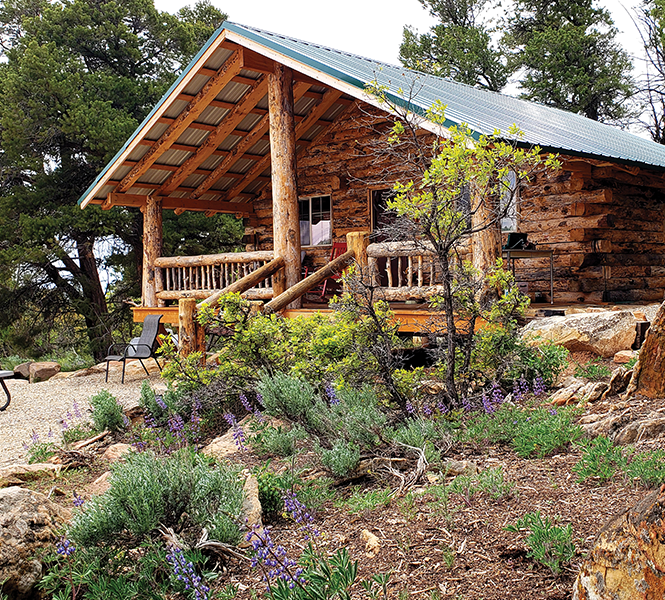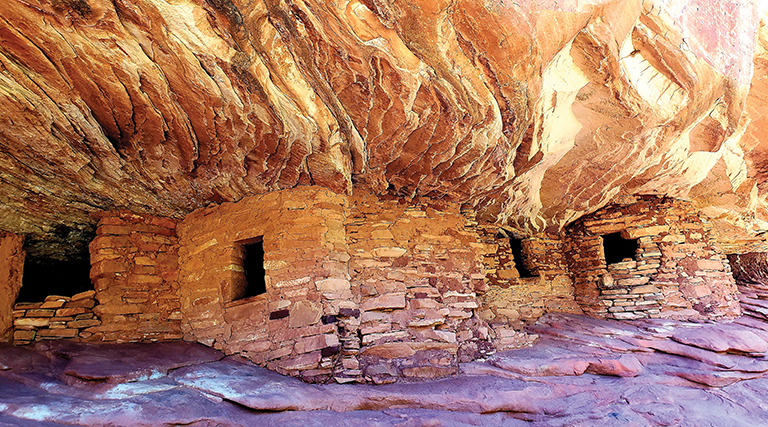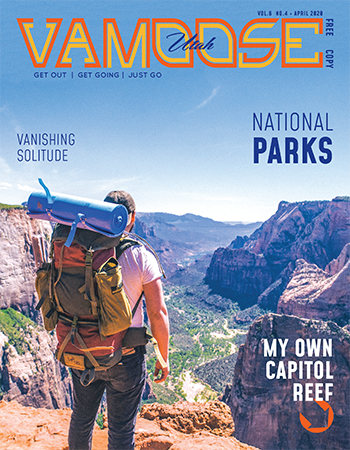Rustic abodes offer true peace and quiet
By Jared Blackley
There are myriad reasons to visit Moab in the spring. The hordes of spring breakers aren’t one of them.
This spring, maybe skip the crowds and point your headlights south as you pass through Moab and keep driving for another hour to a quieter and more secluded setting.
Or better yet, bypass Moab altogether. Turn west at Interstate 70 from U.S. Highway 6, near Green River, and follow the signs to Hanksville. From there, take Utah Highway 95 southeast over Cedar Mesa into Blanding. The views along the way rival any you’ll see on any desert highway in the U.S. Period.
Book a stay at the Abajo Haven Cabins (5440 N. Cedar Edge Lane, Blanding, 435-979-3126, AbajoHaven.com), located on a 25-acre property near Blanding. The property is next door to a national forest and offers eye-popping views of the 11,000-foot-high Abajo Mountains dominating the northern skyline.
The southeastern view takes in the vast expanse of desiccated rock and desert canyons all the way to Sleeping Ute Mountain in Colorado. Wild turkey and deer are frequent visitors.
With five guest cabins, you can select the superior cabin, with two queen beds and en-suite bathroom, or one of four deluxe cabins with a king bed and two singles (their restroom with hot water and tiled shower is just outside the cabin). Relax with a good book on the covered porches or view the surrounding desert area or starry, starry night sky.
The owner, Bill Haven, purchased the property 12 years ago with his family, after he retired as a professional horse trainer and sold their ranch in Colorado. “My [three] boys really like outdoor recreation and were not much into horses,” he says, “So, we thought, ‘let’s sell our horse ranch and move to the outdoor recreation center of the West: San Juan County, Utah.’”
The cabins are solar powered and off-grid, so leave those curling irons, blow dryers and electric razors at home. The nearest restaurants are a 15-minute drive to Blanding.
With at least one day’s notice, Haven will prepare a home-cooked meal of either his famous ribs or chicken for $20. After the first meal, guests can order a la carte for a lesser price if meals prove to be too much food.

Abajo Haven Guest Cabins are solar powered
Each cabin has a fire pit, Coleman stove, gas grill and picnic table. If guests wish to cook their own meals, the Haven can supply all basic cooking utensils, including pots, pans, plates, cups and silverware.
Slowly cooking dinner in a Dutch oven in the fire pit could put a cherry on top of a day spent hiking and exploring Johnson Creek or touring the Dinosaur Museum in Blanding (BYO Dutch oven, though).
Because Blanding is a dry town, you’ll need to pack in your own alcoholic beverages. There are no liquor stores or drinks served at restaurants. If requested, the property will supply a cooler with ice, a corkscrew and glasses.
“The cabins are a little rustic,” Haven says, “but that is part of their charm. They offer something most other accommodations don’t—peace and quiet.” There are also a few, small archeological sites within walking distance from the cabin. Haven can point the way for you.
Corrals and pens are available for those who bring their own horses. (Abajo Haven does not provide horses, nor do they offer guided rides.) Be sure to bring your own hay and feed and all papers required by the state.
Haven rides his horses in the area often and is more than happy to share his love and knowledge of the myriad trails nearby. His goal is to make sure you enjoy your stay in Canyon Country and end up loving the area, too.
While You’re There
The Edge of Cedars State Park (Stateparks.utah.gov/parks/edge-of-the-cedars) in Blanding is a little-known gem just 20 minutes away from Abajo Haven. Housing the largest collection of Ancestral Puebloan (Anasazi) pottery in the Four Corners region, it also features ruins to explore and a restored kiva that you can climb down a ladder to see.
Evidence of Ancestral Puebloan peoples living in this area is abundant. Almost every canyon contains petroglyphs, a granary or a ruin of some sort, and most of these are between 800-1,200 years old.
Some of the most spectacular sites include Moonhouse and House on Fire ruins. Only 20 people per day are allowed in to see Moonhouse Ruins. Permits must be obtained through the Kane Gulch Visitor Center on Cedar Mesa (Recreation.gov/permits/273374). The hike is approximately 4½ miles round trip. Bring plenty of water.
House on Fire Ruins, named for the flame-like pattern on the ceiling of the alcove, does not require a permit. The hike is relatively easy, following a creek bed for most of the single mile to the ruins. Avoid the trail if rain is forecast, as flash floods are a possibility. Of course, if you find any artifacts, look at them, take pictures, but don’t move them. And above all, don’t take them home.
A little over an hour away, on top of the spectacular Cedar Mesa, is Natural Bridges National Monument (NPS.gov/nabr/index.htm). Founded in 1908, it’s the state’s first national monument and is known for three large natural bridges that can all be viewed after a short hike from the road. For those seeking a longer hike, there are three loops that are more than 5½ miles in length. The longest is almost 10 miles and takes you to all three of the main natural bridges.



